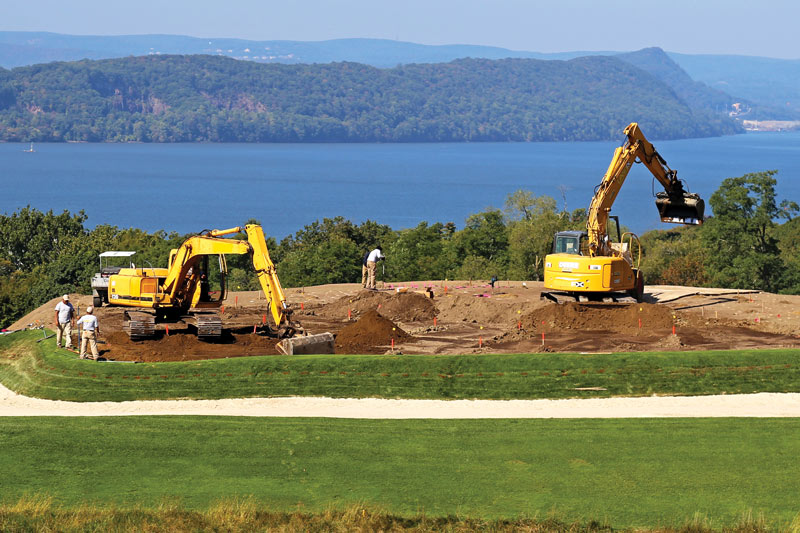
The first edition of “USGA Recommendations for a Method of Putting Green Construction” was produced in 1960. This year’s publication is the sixth version of the document, which incorporates scientific and technological advancements that have occurred since the previous revision in 2004. Photos courtesy of the USGA
Golfers around the world enjoy playing on smooth, healthy putting greens, but rarely, if ever, do golfers consider that the soil and drainage system beneath those greens have a substantial impact on the quality of the playing surfaces.
The “USGA Recommendations for a Method of Putting Green Construction” (referred to in this article as “the recommendations”) is a proven method to produce and maintain consistent, high-quality playing conditions and healthy turfgrass across a wide range of climates. A USGA green features a layered design, including a stable subgrade and drainage pipe overlaid by a 4-inch (10-cm) gravel layer and a 12-inch (30.4-cm) layer of sand-based root-zone mix.
The materials used to build a USGA green are carefully selected to withstand golfer and maintenance traffic, drain rapidly and provide a healthy growing environment for putting green turf. In many cases, USGA agronomists assist with the process of material and turfgrass selection to ensure the best results.
Since their original publication in 1960, the recommendations have been updated in 1973, 1989, 1993, 2004 and, most recently, in February. Each revision was geared toward incorporating advancements in technology and more sustainable construction materials and methods in addition to scientific research and practical experience.
A brief history of the USGA green
The USGA first published its recommendations for green construction to help golf courses overcome the challenges of greater demand for play and higher golfer expectations. Before 1960, putting greens were constructed primarily with native soils or various mixtures of sand, soil and organic matter. Greens were highly sloped to encourage surface drainage, but internal drainage was often limited — if it was present at all. These early greens were plagued by problems such as compaction and poor drainage, and suffered from inconsistent construction methods and materials.
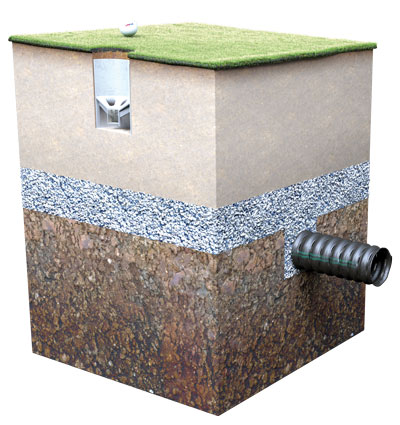
Right: The classic USGA recommendations for putting green construction prescribe a stable subgrade and drainage pipe covered by a 4-inch layer of gravel, which is topped by a 12-inch layer of sand-based root-zone mix. Illustration courtesy of the USGA
To overcome such challenges, in the early 1950s, Marvin Ferguson, Ph.D., then the USGA’s turfgrass research coordinator and mid-continent director, conducted scientific research on engineered soils that would prevent compaction and exhibit desirable drainage characteristics. Dr. Ferguson’s research ultimately led to the first publication of the USGA method for putting green construction in 1960.
Since then, the original design of the USGA green has remained intact, but as materials change and new research reveals better technology and methods for putting green construction, the recommendations are updated.
Is the USGA method right for you?
Although the USGA method of putting green construction has been used successfully throughout the world, other techniques can also produce excellent results. Some areas are rich in naturally occurring sandy soils — for example, in the Melbourne Sandbelt, the sand depth is more than 200 feet. In such cases, local materials can be used successfully without the need to import sand and gravel.
Furthermore, the research suggests potential benefits to new construction concepts, such as varying the depth of the root-zone mixture or using the Airfield system. Although such methods are not currently included in the USGA recommendations, USGA agronomists will eagerly assist courses interested in alternative putting green construction.
No matter which method is chosen, the science behind the USGA method, dating back to the 1950s, should be used to optimize the performance and customize the putting green root-zone characteristics for your site conditions.
Why revise the USGA recommendations?
The revision process is necessary to take advantage of new scientific research, modern construction techniques and technology, and advancements in material testing methods. From a structural and technical standpoint, only minor changes were made to the updated recommendations. The biggest change readers will find is expanded discussion and explanation of how to customize root-zone materials to meet a course’s specific growing environment and golfer expectations.
Who was involved in the review process?
Individuals representing all facets of constructing golf course putting greens were included in the revision process. The goal was to leave no stone unturned with regard to reviewing and revising the 2004 recommendations.
This selected group of industry professionals — including university scientists, representatives from the A2LA-accredited physical soil testing laboratories, golf course builders, sand and organic matter suppliers, golf course architects, golf course superintendents, and the USGA agronomists — all provided feedback during the 18-month review process. The review team met frequently online to discuss every aspect of putting green construction. The review process also included several trips to soil-testing laboratories, research facilities, sand-blending operations and putting green construction sites.
The proposed edits and updates were compiled, and a small group from the USGA met with Norm Hummel, Ph.D., to begin the revision process. Next, a series of drafts developed by Dr. Hummel were reviewed by the USGA team over several months. The new recommendations were published in the USGA Green Section Record on Feb. 16, 2018.
Revision objectives
The process of updating the recommendations and providing supporting materials focused on four objectives.
- Review and evaluate new technology. The revised recommendations reflect currently available testing methods for determining the suitability of materials for putting green construction.
- Better educate the practitioner. The revised recommendations clarify the steps needed to construct a USGA green, and provide the practitioner with information necessary to customize the construction materials based on their local site conditions and golfer expectations. The USGA also updated the document “Building the USGA Putting Green: Tips for Success” to reflect modern construction techniques and technology. This document contains information that will help golf course builders and superintendents successfully build USGA putting greens.
- Maintain the broad range of application. The revised recommendations preserve their broad applicability, ensuring they remain useful to golf courses around the world.
- Consider alternative methods for construction. The potential benefits and pitfalls of alternative construction methods are recognized and discussed in the USGA publication “Building the USGA Putting Green: Tips for Success.”
Summary of changes made to the recommendations
The 2018 “USGA Recommendations for a Method of Putting Green Construction” lists eight steps to educate readers on the characteristics of a USGA green. The following summarizes the revisions made within each step.
Step 1. Assemble your team
The 2004 version of the recommendations did not include this step. The industry professionals on the review committee felt it necessary to stress the importance of compiling a trusted team to design, implement, build and maintain a new USGA putting green. Typically, such a team includes an architect, golf course superintendent and golf course builder.
Step 2. The putting green cavity and subgrade
The recommendations for building the subgrade changed only slightly, with added comments on compacting and stabilizing the subgrade. Specific changes are listed below.
- If soil is used to construct the subgrade, it should be installed in 6-inch (15.2-cm) lifts and compacted to at least 90% minimum standard Proctor density as determined by the Proctor compaction test ASTM D698.
- The 2018 revision encourages courses to consult with a local geotechnical engineer should they encounter unstable soils such as those containing shrink/swell clays, soft sands or high concentrations of organic material. The document Building the USGA Putting Green: Tips for Success provides additional explanation on using lime or geotextile fabric as stabilization methods.
Step 3. Drainage
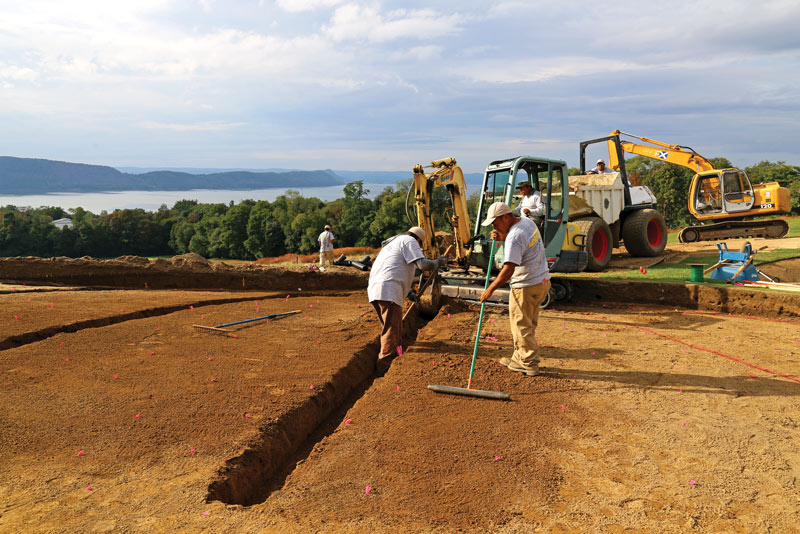
Drainage pipes in the putting green should be placed no more than 15 feet apart and have a continuous slope of 0.5% or more to the main drain line.
USGA agronomists and the golf course superintendents on the review committee shared experiences observing chronically wet root-zone conditions in low-lying areas at the perimeter of putting greens. In some instances, the perimeter drain (sometimes referred to as the “smile drain”) was installed several feet from the cavity perimeter rather than immediately at the edge of the putting green cavity. Several changes were made based on these observations.
- Install clean-out ports (flush-outs) upstream and downstream of the putting green, and add metal to the cap of the risers to facilitate easy location with a metal detector.
- Install perimeter drains in all areas where water could accumulate adjacent to the cavity wall — not just at the front of the green. In addition, perimeter drains should be installed immediately against the cavity wall.
Step 4. Gravel and intermediate layer
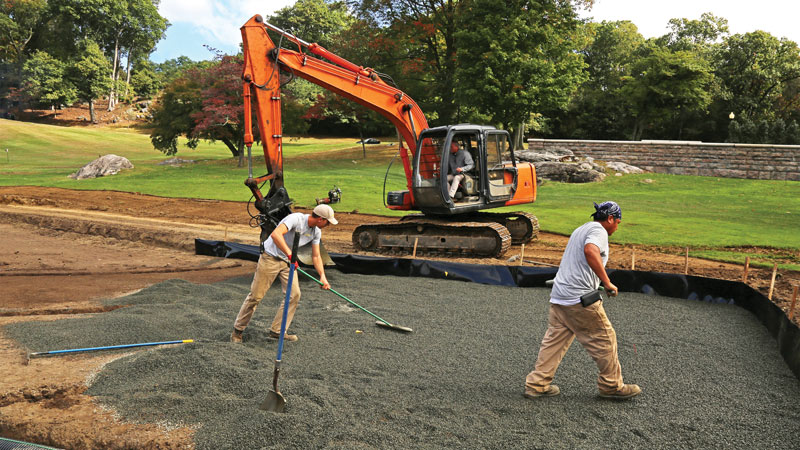
In the new recommendations, courses are cautioned that placing low-pH root-zone mixtures over high-pH gravel could cause iron oxide layers to form between the root-zone and gravel layers.
- The intermediate layer remains an option in the USGA green, but experience has shown this layer is rarely necessary. The changes in this step focus on new technology for testing material stability and alerting courses to a potential construction pitfall with the formation of iron oxide layers (a cemented layer) at the sand/gravel interface.
- The plastic barrier (the wicking barrier) that is sometimes installed vertically at the green perimeter is considered optional in a USGA green. Additional information on the use of this plastic liner is available in the document Building the USGA Putting Green: Tips for Success.
- The laboratory professionals identified the Micro-Deval abrasion test (ASTM D6928) as the preferred method for evaluating the mechanical stability of gravel. This test is more accurate and repeatable when compared with the formerly used sulfate soundness and L.A. Abrasion test. The Micro-Deval method tests the stability of material when immersed in water, which more closely replicates the conditions the gravel will endure in a putting green environment.
- Finally, the review committee unanimously agreed it was important to educate courses on the potential hazard of placing low-pH root-zone mixtures over high-pH gravel materials. This scenario may contribute to the formation of iron oxide layers at the root-zone and gravel interface. The USGA is continuing to fund research on this topic to discover preventive and curative solutions.
Step 5. The root-zone mixture
The section on selecting a root-zone mixture was a focus of the 2018 revisions and received much of the attention during the revision process.
The 2018 revision better educates the reader on the intricacies of selecting a root-zone material, and allows courses to customize root-zone mixes to fit the local environmental conditions and golfer expectations at their facility. For example, because of golfer feedback, some courses have expressed interest in providing very firm putting surfaces. This document explains how to select sand root-zone materials that are more likely to provide such conditions. The primary revisions in Step 5 are listed below.
- Expanded explanation of root-zone materials. The 2018 revision delivers better guidance on how to customize the root-zone mixture for your site conditions and golfer expectations.
- Calcareous sands. Highly calcareous sands such as coral should be avoided for root-zone material.
- Root-zone stability and putting green firmness. A CU range (coefficient of uniformity) has been included. The CU should range from 1.8 to 3.5 for mixtures containing peat, and from 2 to 3.5 for mixes with sand only or with sand amended with inorganic materials.
- Sand shape. In addition to influencing the coefficient of uniformity, sand shape also affects stability and putting green firmness.
- Organic matter selection. There is expanded information on using various organic amendments, including composts, along with the recommended chemical and physical characteristics when using such materials.
- Value-added products. Other organic products such as biochar, humates, seaweed products and vermiculture byproducts are described as “value-added” and not a replacement for peat or inorganics. Dr. Hummel stressed that, if these products are used, courses must include the products at the intended rate in the performance testing evaluation.
- Physical properties of the root-zone mixture. The recommended infiltration rate (Ksat) remains unchanged at a minimum of 6 inches per hour. However, the review committee commented that historically, too much emphasis has been placed on this one characteristic without much thought given to moisture retention. Therefore, the section on the physical properties of the root-zone mixture has been enhanced to better explain the moisture-retention characteristics of a root-zone mix. This document emphasizes moisture retention — that is, capillary porosity — while retaining air porosity. In the recommendations, Dr. Hummel wrote, “if the capillary porosity of a root-zone mix is within the recommended range, the mix should not be excessively droughty even if the Ksat is high.” Therefore, courses can have their cake and eat it too! They can have ample water infiltration rates and still have adequate moisture retention with the right mixture.
- Quality control testing. There is expanded discussion and explanation of using the provided confidence intervals to evaluate the quality of the root-zone materials through the green construction process. A few of the confidence intervals were expanded based on feedback from the laboratory personnel, the sand-blending companies and the soil experts on the review committee. For example, the infiltration rate confidence interval increased to 25% (from 20%) to account for the variability of this laboratory test. For more information on how to accurately sample sand and root-zone piles, read the article Quality control sampling of sand and root-zone mixture stockpiles.
- Root-zone mix blending. There is an expanded discussion on the do’s and don’ts of mixing root-zone components. Using specialized equipment made for producing consistent root-zone mixtures is recommended, while tactics such as loader-bucket flipping, farm implement mixing or rototilling in the putting green cavity are strongly discouraged.
Step 6. Root-zone placement

Gravels and root-zone mixtures should be tested by an A2LA-accredited laboratory to determine which gravels will bridge with a selected root-zone mixture.
Step 6, which discusses placing, smoothing and firming the root-zone mixture, underwent minimal changes.
- There is expanded discussion on using appropriate equipment to spread the root zone across the gravel and avoiding trucks that may compromise the construction.
- In some instances, the putting green root zone has settled, especially near the perimeter. Therefore, a discussion was added to stress the importance of moistening the root-zone mixture during the spreading process and power-tamping along the perimeter and where grade stakes were located to firm these areas. Finally, this section recommends heavy watering from irrigation after grade is reached in order to settle the root zone. After irrigation, the depth should be checked and root-zone material should be added or removed where necessary.
Step 7. Pre-plant preparation and establishment
The 2004 version of the recommendations covered sterilization, and the updated version expands the discussion to fertility inputs and incorporating fertilizer, fumigation and tips for sodding.
- Pre-plant fertilizer. Because nutrient retention will be low in the new root-zone mixture, courses are encouraged to submit samples for nutrient testing. Mix the pre-plant fertilizer as uniformly as possible into the top 2 inches before smoothing.
- Fumigation. Fumigation is suggested in areas with known severe nematode infestations and with documented severe weed problems.
- Sodding. It is recommended to grow sod on the same root zone or on a root zone with characteristics very similar to those of the construction mixture. Under no circumstances should a sod grown on soil containing fine material such as silt and clay be placed over a sand root-zone mixture.
Step 8. Grow-in
- Superintendents recognize that grow-in methods and strategies can vary widely from one course to another, and even at the same property, depending on the weather conditions at the time of grow-in. That’s not to mention the different grasses and cultivars, golfer expectations, and wide variations in budgets and golf course superintendent experience. Therefore, it is not practical to include specific grow-in suggestions in the USGA recommendations for putting green construction. However, the document Building the USGA Putting Green: Tips for Success offers a sample grow-in fertility schedule and general guidelines to consider for growing in a new putting green.
Future considerations
The review committee dedicated significant time to considering alternative construction methods for inclusion in the 2018 recommendations. Some of those topics are listed below.
- Variable-depth construction. The idea behind the variable-depth root-zone is to improve surface moisture consistency across a sloping putting green. Essentially, this method involves shallowing the root-zone depth to 8 to 10 inches (20.3-25.4 cm) on mounds and increasing the depth to 14 to 16 inches (35.6-40.6 cm) in low-lying areas. While research demonstrated merit to this idea, these current construction methods are more art than science. The USGA will continue to evaluate this method.
- Slope and materials used at the interface of the green cavity and green surround/approach. Currently, the USGA method recommends the cavity wall be 90 degrees to the subgrade floor or steeply sloped, but some courses have recognized benefits from transitioning the sand in the green cavity out into the approach or closely mowed areas around greens. However, at this point, there are no specific guidelines on the slope and depth requirements in these areas outside the green cavity.
- Solutions to remediate iron oxide layers. The USGA continues to fund research on strategies to either prevent or remediate cemented layers that may form at the sand/gravel interface under specific circumstances. Currently, it is suggested that courses avoid placing a low-pH sand root zone over an alkaline-pH gravel.
- Water movement with and without the wicking barrier. The wicking barrier is a plastic membrane that may be installed vertically at the putting green cavity wall to prevent moisture from wicking from the porous-sand root zone into a finer-textured soil in the green surround. Many superintendents and USGA agronomists have observed higher moisture content at the low end of greens where this barrier has been installed, but when it is removed, the moisture content decreases to more desirable levels. While there are instances in which this plastic, impermeable layer may be beneficial, there is a desire to conduct research that would better quantify water movement with and without the wicking barrier in a variety of soil conditions.
- Geotextile fabrics. There are potential savings and benefit that may be derived from using geotextile fabrics in putting green construction. For example, imagine using on-site rock and placing a geotextile fabric rather than gravel over the top to support the sand-based root zone. Research on the Airfield system, which uses a geotextile fabric over a 1-inch-thick (2.5-cm-thick) plastic grid, revealed this system stores 0.5 inch (1.3 cm) more water in the root zone when compared with a gravel- based system, potentially reducing water use. However, numerous members on the review committee expressed reservations about the longevity and integrity of the geotextile fabrics. As such, these materials are currently not included in the recommendations, but further research may shed light on whether new technology in geotextiles will hold up over time.
- Crumb rubber. Crumb rubber was discussed during one of the review committee meetings as an alternative for gravel. The USGA is interested in strategies and technology that will lessen the cost of constructing putting greens and take advantage of recycled materials. At this point, more research is required to confidently recommend such materials.
- Carbonate dissolution in root zone and gravel. There has been discussion among the review committee regarding the potential for root-zone materials containing high concentrations of calcium carbonate to dissolve over time with neutral or low-pH irrigation water. The result of such dissolution could be a decrease in aeration porosity and saturated hydraulic conductivity — not from carbonate cementation, but rather an increase in very fine sand or silt and clay. While this issue has been reported, there is little scientific research, and the intent is to investigate whether this is a problem that requires adjustments to the recommendations.
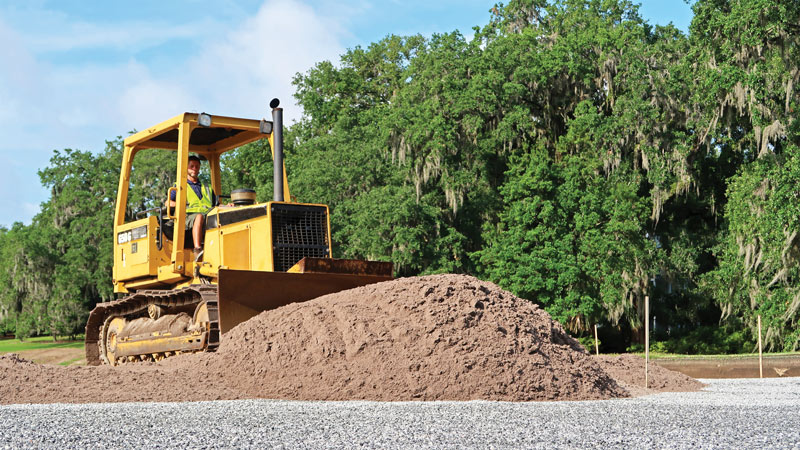
When the root zone is installed, the mixture should be dumped on the edge of the putting green cavity, spread across the gravel layer, and then firmed to a depth of 12 inches, with a tolerance of plus or minus 1 inch.
Conclusion
The 2018 revisions to the “USGA Recommendations for a Method of Putting Green Construction” were the result of an industry-wide collaborative effort. The review committee considered relevant research, new technology, alternative materials and new construction methods. The revised document has an expanded and enhanced discussion on root-zone selection, designed to allow courses to optimize and customize root-zone characteristics for their specific site conditions and golfer expectations.
Acknowledgments
Thank you to the participants on the putting green recommendations review committee, the USGA Green Section staff, and Dr. Norm Hummel for their valued assistance and input during the review process.
The research says ...
- The USGA recommendations for green construction were revised in 2018 to take advantage of new scientific research, modern construction techniques and technology, and advancements in material testing methods.
- In many cases, local materials can be used successfully without the need to import sand and gravel.
- The revised recommendations focus on new technology for testing material stability and the possibility of iron oxide layers forming at the sand/gravel interface.
- A discussion of alternative construction methods includes variable-depth construction, geotextile fabrics, crumb rubber, carbonate dissolution in root zone and gravel, and other topics.
- The biggest change is the expanded discussion on customizing root-zone materials to meet a course’s specific growing environment and golfer expectations.
References
- Frank, K.W., B.E. Leach, J.R. Crum, P.E. Rieke, B.R. Leinauer, T.A. Nikolai and R.N. Calhoun. 2005. Effect of root-zone material and depth on moisture retention in undulating USGA putting greens. USGA Turfgrass and Environmental Research Online 4(11):1-9 (June 1, 2005). (http://usgatero.msu.edu/v04/n11.pdf) Accessed April 25, 2018.
- Obear, G.R., and D.J. Soldat. 2014. Iron-cemented layers in putting green soils. Golf Course Management 82(4):96-100.
- USGA. 2015. An alternative to the gravel in USGA putting greens. (www.usga.org/course-care/an-alternative-to-the-gravel-in-usga-putting-greens-21474858770.html) Accessed April 25, 2018.
- USGA. 2015. Iron layer development in sand-based greens. (www.usga.org/course-care/iron-layer-development-in-sandbased-greens-21474861127.html) Accessed April 25, 2018.
- USGA. 2015. Quality control sampling of sand and root-zone mixture stockpiles. (http://gsrpdf.lib.msu.edu/ticpdf.py?file=/article/anon-quality-01-22-16.pdf) Accessed April 25, 2018.
- USGA. 2018. Building the USGA putting green: Tips for success. (http://archive.lib.msu.edu/tic/usgamisc/monos/tipsforsuccess-2018.pdf) Accessed April 25, 2018.
- USGA. 2018. USGA recommendations for a method of putting green construction. United States Golf Association, Liberty Corner, N.J. (http://archive.lib.msu.edu/tic/usgamisc/monos/2018recommendationsmethodputtinggreen.pdf) Accessed April 25, 2018.
- USGA. 2018. What is a USGA green? (www.usga.org/course-care/infographics/what-is-a-usga-putting-green.html) Accessed April 25, 2018.
- USGA Green Section. 2018. Genesis and prevention of layers in putting green root zone profiles. (http://www.usga.org/content/usga/home-page/course-care/turfgrass-and-environmental-research/research-updates/2018/genesis-and-prevention-of-layers-in-putting-green-rootzone-profi.html) Accessed April 25, 2018.
Brian Whitlark is an agronomist for USGA’s West region and is based in Gilbert, Ariz.